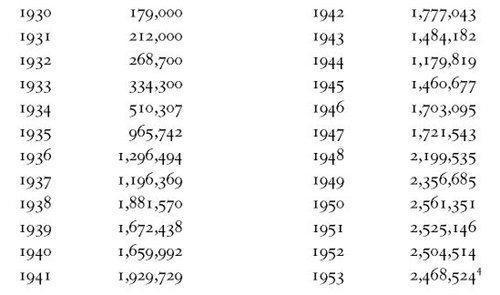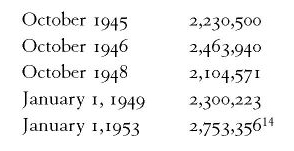Gulag (85 page)

But then, very few people in contemporary Russia feel the past to be a burden, or as an obligation, at all. The past is a bad dream to be forgotten, or a whispered rumor to be ignored. Like a great, unopened Pandora’s box, it lies in wait for the next generation.
Our failure in the West to understand the magnitude of what happened in the Soviet Union and central Europe does not, of course, have the same profound implications for our way of life as it does for theirs. Our tolerance for the odd “Gulag denier” in our universities will not destroy the moral fabric of our society. The Cold War is over, after all, and there is no real intellectual or political force left in the communist parties of the West.
Nevertheless, if we do not start trying harder to remember, there will be consequences for us too. For one, our understanding of what is happening now in the former Soviet Union will go on being distorted by our misunderstanding of history. Again, if we really knew what Stalin did to the Chechens, and if we felt that it was a terrible crime against the Chechen nation, it is not only Vladimir Putin who would be unable to do the same things to them now, but we also would be unable to sit back and watch with any equanimity. Nor did the Soviet Union’s collapse inspire the same mobilization of Western forces as the end of the Second World War. When Nazi Germany finally fell, the rest of the West created both NATO and the European Community—in part to prevent Germany from ever breaking away from civilized “normality” again. By contrast, it was not until September 11, 2001, that the nations of the West seriously began rethinking their post–Cold War security policies, and then there were other motivations stronger than the need to bring Russia back into the civilization of the West.
But in the end, the foreign-policy consequences are not the most important. For if we forget the Gulag, sooner or later we will find it hard to understand our own history too. Why did we fight the Cold War, after all? Was it because crazed right-wing politicians, in cahoots with the military-industrial complex and the CIA, invented the whole thing and forced two generations of Americans and West Europeans to go along with it? Or was there something more important happening? Confusion is already rife. In 2002, an article in the conservative British
Spectator
magazine opined that the Cold War was “one of the most unnecessary conflicts of all time.”
11
The American writer Gore Vidal has also described the battles of the Cold War as “forty years of mindless wars which created a debt of $5 trillion.”
12
Already, we are forgetting what it was that mobilized us, what inspired us, what held the civilization of “the West” together for so long: we are forgetting what it was that we were fighting against. If we do not try harder to remember the history of the other half of the European continent, the history of the other twentieth-century totalitarian regime, in the end it is we in the West who will not understand our past, we who will not know how our world came to be the way it is.
And not only our own particular past. For if we go on forgetting half of Europe’s history, some of what we know about mankind itself will be distorted. Every one of the twentieth-century’s mass tragedies was unique: the Gulag, the Holocaust, the Armenian massacre, the Nanking massacre, the Cultural Revolution, the Cambodian revolution, the Bosnian wars, among many others. Every one of these events had different historical, philosophical, and cultural origins, every one arose in particular local circumstances which will never be repeated. Only our ability to debase and destroy and dehumanize our fellow men has been—and will be—repeated again and again: our transformation of our neighbors into “enemies,” our reduction of our opponents to lice or vermin or poisonous weeds, our re-invention of our victims as lower, lesser, or evil beings, worthy only of incarceration or explusion or death.
The more we are able to understand how different societies have transformed their neighbors and fellow citizens from people into objects, the more we know of the specific circumstances which led to each episode of mass torture and mass murder, the better we will understand the darker side of our own human nature. This book was not written “so that it will not happen again,” as the cliché would have it. This book was written because it almost certainly will happen again. Totalitarian philosophies have had, and will continue to have, a profound appeal to many millions of people. Destruction of the “objective enemy,” as Hannah Arendt once put it, remains a fundamental object of many dictatorships. We need to know why—and each story, each memoir, each document in the history of the Gulag is a piece of the puzzle, a part of the explanation. Without them, we will wake up one day and realize that we do not know who we are.
Appendix
HOW MANY?

ALTHOUGH THE SOVIET UNION contained thousands of concentration camps, and although millions of people passed through them, for many decades the precise tally of victims was concealed from all but a handful of bureaucrats. As a result, estimating their numbers was a matter of sheer guesswork while the USSR existed, and remains a matter of educated guesswork today.
During the era of sheer guesswork, the Western debate about the statistics of repression—just like the more general Western debate about Soviet history—was tainted, from the 1950s on, by the politics of the Cold War. Without archives, historians relied alternately on prisoners’ memoirs, defectors’ statements, official census figures, economic statistics, or even minor details which somehow became known abroad, such as the number of newspapers distributed to prisoners in 1931.
1
Those more inclined to dislike the Soviet Union tended to choose the higher figures of victims. Those more inclined to dislike the American or Western role in the Cold War chose the lower figures. The numbers themselves ranged wildly. In
The Great Terror
, his then groundbreaking 1968 account of the purges, the historian Robert Conquest esimated that the NKVD had arrested seven million people in 1937 and 1938.
2
In his 1985 “revisionist” account, Origins of the Purges, the historian J. Arch Getty wrote of merely “thousands” of arrests in those same two years.
3
As it turned out, the opening of the Soviet archives gave neither school complete satisfaction. The first sets of figures released for Gulag prisoners seemed at first to show numbers lying squarely in the middle of the high and low estimates. According to widely published NKVD documents, these were the numbers of prisoners in Gulag camps and colonies from 1930 to 1953, as counted on January 1 of each year:

These numbers do reflect some things that we know, from many other sources, to be true. The inmate figures begin to rise in the late 1930s, as repression increased. They dip slightly during the war, reflecting the large numbers of amnesties. They rise in 1948, when Stalin clamped down once again. On top of all that, most scholars who have worked in the archives now agree that the figures are based on genuine compiliations of data provided to the NKVD by the camps. They are consistent with data from other parts of the Soviet government bureaucracy, tallying, for example, with data used by the People’s Commissariat of Finance.
5
Nevertheless, they do not necessarily reflect the whole truth.
To begin with, the figures for each individual year are misleading, since they mask the camp system’s remarkably high turnover. In 1943, for example, 2,421,000 prisoners are recorded as having passed through the Gulag system, although the totals at the beginning and end of that year show a decline from 1.5 to 1.2 million. That number includes transfers within the system, but still indicates an enormous level of prisoner movement not reflected in the overall figures.
6
By the same token, nearly a million prisoners left the camps during the war to join the Red Army, a fact which is barely reflected in the overall statistics, since so many prisoners arrived during the war years too. Another example: in 1947, 1,490,959 inmates entered the camps, and 1,012,967 left, an enormous turnover which is not reflected in the table either.
7
Prisoners left because they died, because they escaped, because they had short sentences, because they were being released into the Red Army, or because they had been promoted to administrative positions. As I’ve written, there were also frequent amnesties for the old, the ill and for pregnant women—invariably followed by new waves of arrests. This massive, constant movement of prisoners meant that the numbers were in fact far higher than they seemed to be it first: by 1940, eight million prisoners had already passed through the camps.
8
Using the inflow and outflow statistics available, and reconciling a variety of sources, the only complete reckoning I have seen estimates that eighteen million Soviet citizens passed through the camps and colonies between 1929 and 1953. This figure also tallies with other figures given by senior Russian security officials during the 1990s. According to one source, Khrushchev himself spoke of seventeen million passing through the labor camps between 1937 and 1953.
9
Yet in a deeper sense, this figure is misleading too. As readers will also by now be aware, not every person condemned to forced labor in the Soviet Union actually served out his time in a concentration camp run by the Gulag administration. For one, the figures above exclude the many hundreds of thousands of people who were sentenced to “forced labor without incarceration” for workplace violations. More important, there were at least three other significant categories of incarcerated forced laborer: prisoners of war, postwar inhabitants of filtration camps, and above all the “special exiles,” who included kulaks deported during collectivization, Poles, Balts, and others deported after 1939, and Caucasians, Tartars, Volga Germans, and others deported during the war itself.
The first two groups are relatively easy to count: from several reliable sources, we know that the number of POWs exceeded four million.
10
We also know that between December 27, 1941, and October 1, 1944, the NKVD investigated 421,199 detainees in filtration camps, and that on May 10, 1945, over 160,000 detainees were still living in them, engaged in forced labor. In January 1946, the NKVD abolished the camps and repatriated a further 228,000 to the USSR for further investigation.
11
A total of about 700,000 seems, therefore, a fair guess.
The special exiles are somewhat harder to count, if only because there were so many different exile groups being sent to so many different places at so many different times for so many different reasons. In the 1920s, many of the Bolsheviks’ early opponents—Mensheviks, Social Revolutionaries, and the like—were exiled by administrative decree, which meant they were not technically part of the Gulag, but were certainly being punished. In the early 1930s, 2.1 million kulaks were exiled, although an unknown number, certainly in the hundreds of thousands, were sent not to Kazakhstan or Siberia, but to other parts of their native province or to bad land at the edges of their collective farms: since many seem to have escaped, it is hard to know whether to count them or not. Much clearer is the position of the national groups exiled during and after the war to the “special exile” villages. Equally clear, yet much easier to forget, are odd groups like the 17,000 “former people” expelled from Leningrad after Kirov’s murder. There were also Soviet Germans who were not physically deported, but whose villages in Siberia and central Asia were turned into “special settlements”—the Gulag came to them, as it were—as well as babies born to exiles, who surely count as exiles too.
As a result, those who have tried to collate the many statistics that have been published about each of these different groups have come up with slightly different numbers. In
Ne po svoei vole
, published by Memorial in 2001, the historian Pavel Polyan has added up the numbers of special exiles and got a figure of 6,015,000.
12
In a survey of archival publications, Otto Pohl, on the other hand, counts just over seven million special exiles from 1930 to 1948.
13
He gives the postwar figures for people living in “special settlements” as follows:

Still, on the principle that the low estimate will satisfy the more fastidious, I have decided to choose Polyan’s number: six million exiles. Adding the numbers together, the total number of forced laborers in the USSR comes to 28.7 million.
I realize, of course, that this figure will not satisfy everybody. Some will object that not all of those arrested or deported count as “victims,” since some were criminals, or even war criminals. Yet although it is true that millions of these prisoners had criminal sentences, I do not believe that anything close to the majority were actually “criminals,” in any normal sense of the word. A woman who has picked a few pieces of grain from a field which has already been harvested is not a criminal, nor is a man who has been late to work three times, as was the father of the Russian General Alexander Lebed, who received a camp sentence for precisely that. For that matter, a prisoner of war who has been deliberately kept in a forced-labor camp many years after the war has come to an end, is not a legitimate prisoner either. By all accounts, the number of genuine professional criminals in any camp was tiny—which is why I prefer to leave the numbers as they are.
Others, however, will be unsatisfied with this figure on different grounds. Certainly in the course of writing this book, I have been asked the same question many, many times: Of these 28.7 million prisoners, how many died?
This answer is complicated too. To date, no completely satisfactory death statistics for either the Gulag or the exile system have yet appeared.
15
In the coming years, some more reliable numbers may emerge: at least one former MVD officer has personally taken it upon himself to comb methodically through the archives, camp by camp and year by year, trying to compile authentic numbers. With perhaps somewhat different motives, the Memorial Society, which has already produced the first reliable guide to the numbers of camps themselves, has set itself the task of counting the victims of repression too.
Until these compilations appear, however, we have to rely upon what we have: a year-by-year account of Gulag death rates, based on the archives of the Department of Prisoner Registration. This account seems to exclude deaths in prisons and deaths during transport. It has been compiled using overall NKVD reports, not the records of individual camps. It does not include special exiles at all. Nevertheless, I record it here, reluctantly:


